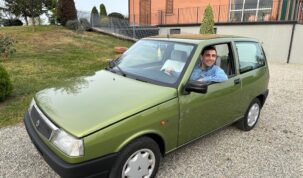- by Dave Lewandowski
- indycar.com
Indy Racing League officials and Firestone engineers couldn’t pass up the opportunity to potentially create more passing opportunities and solve a technical conundrum at Iowa Speedway.
So they returned to the 0.894-mile racetrack with the compound banking multiple times after last June’s inaugural IndyCar Series race to test alternative aerodynamic packages and tire specifications.
“Iowa was a new track for us last year so we had to make our best guess for our initial setup, which was the Richmond race setup because it’s a small track, similar construction, different banking,” said Les Mactaggart, senior technical director for the sanctioning body. “The (weather) conditions caught us out a little bit. We had unseasonably cold weather, which affects the grip level of the tires and made it a more difficult race than we anticipated in terms of driving on restarts.”
As Marco Andretti, runner-up to Andretti Green Racing teammate Dario Franchitti said, “(The race) was definitely a game of survival.” There were six cautions for 67 of the 250 laps, and Franchitti hugged the bottom of the racing ribbon for a field-high 96 laps on the way to Victory Circle.
Just altering the rear wing angle and reducing downforce wasn’t the answer. Less downforce equals less drag, which would reduce lap times/increase speed and G forces to unsafe levels.
“We decided to go back and have an independent test to see if there was a better aerodynamic package that was better suited to the track,” said Mactaggart, who had four cars simulating traffic in the most recent test. “We went to the extreme and took about 1,500 pounds of downforce off and put plate on the rear wing that created huge amount of turbulence. To balance the car, we ran a speedway front wing and spent two days evaluating cars with different configurations.”
Point A led to B and C, which led series officials – augmented by driver input – to the conclusion that their original configuration was best suited for the venue given seasonal average ambient and track temperatures.
“We took the view we would go back and re-test our original configuration because by this time unification occurred and now instead of having 18 cars there we could have 27 cars,” Mactaggart said. “Just because the track is busier it’s going to be much more difficult for somebody to run around the bottom and prevent someone from overtaking them because there will be slower cars in the equation as well.”
Firestone Racing engineers selected a tire specification using the same left and right side compounds as last year with minor construction changes that should result in slightly more grip. The left side tires will be used at the 1.33-mile Nashville Superspeedway in July, while the right side tires have been utilized at Homestead, Kansas and Texas.
“(Iowa Speedway’s) constant high speeds require a high durability tire that would usually be more associated with a superspeedway than a short oval,” said Al Speyer, executive director of Firestone Racing. “Because we don’t have data from years of racing at this track to draw from, we have tested here multiple times, most recently in early May. This new tire combination should lead to more exciting on-track action for the fans that pack the stands at Iowa Speedway.”




